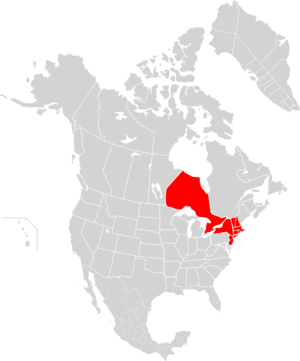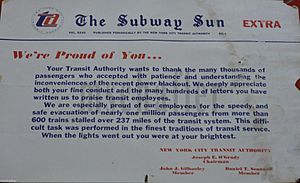Northeast blackout of 1965 facts for kids
The Northeast Blackout of 1965 was a huge power outage. It happened on Tuesday, November 9, 1965. Many areas in Ontario, Canada, and several states in the United States lost electricity. These states included Connecticut, Delaware, Maryland, Massachusetts, New Hampshire, New Jersey, New York, Pennsylvania, Rhode Island, and Vermont. More than 30 million people were without power. The blackout covered a huge area, about 80,000 square miles (207,000 km2). For some, the lights stayed off for up to 13 hours.
Contents
Why Did the Lights Go Out?
A Small Problem Causes a Big Blackout
The main reason for the blackout was a small device called a protective relay. This relay was at the Sir Adam Beck Hydroelectric Power Station No. 2 in Queenston, Ontario, near Niagara Falls. This safety device was set incorrectly. It was supposed to shut down a power line only if other equipment failed.
Cold Weather and Overloaded Lines
It was a very cold November evening. People were using a lot of electricity for heating, lights, and cooking. This pushed the power system to its limits. Power lines going into southern Ontario were carrying a lot of electricity.
The Chain Reaction Begins
At 5:16 p.m. Eastern Time, a small change in power happened. It came from the Robert Moses Niagara Power Plant in Lewiston, New York. This small change caused the wrongly set safety relay to trip. This shut down a main power line going into Southern Ontario.
Suddenly, all the power from that line jumped to other lines. These other lines became overloaded. Their own safety relays then tripped too. This cut off the Beck Station from all of southern Ontario.
Power Spreads and Shuts Down More Plants
The extra power from Beck Station had nowhere to go. It flowed east into New York state. This overloaded those lines as well. Soon, the power from the Niagara region was cut off from the rest of the power grid. The Beck generators then shut down automatically to prevent damage.
The Robert Moses Niagara Power Plant kept working. It supplied power to customers in Buffalo and Niagara Falls, New York. These areas stayed powered up. But other power plants nearby shut down. Within five minutes, the power system was in chaos. Overloads and power losses spread like a wave. The grid broke into smaller "islands." Many power stations shut down automatically. The affected areas included Ontario, New York, and New England. Areas to the south were not affected.
Radio During the Blackout
A DJ Notices Something Strange
A radio station in New York City, WABC, was on air during the blackout. Disc jockey Dan Ingram was hosting his afternoon show. He noticed that a song he was playing sounded slow. The station's music equipment used motors that depended on the power line's speed. Normally, this was 60 Hz.
The Power Slows Down
Recordings from that time show the power line frequency dropped to 56 Hz. This was about six minutes before the blackout. Just two minutes before, it dropped to 51 Hz. As another slow song played, Ingram mentioned the studio lights were dimming. He joked that the electricity itself was slowing down. He said, "I didn't know that could happen."
News Report Fizzles Out
At 5:25 p.m. ET, the station's news report started. The staff did not know about the coming blackout. The main story was about a protest at the United Nations Headquarters. A taped sound bite from a doctor played noticeably slower than usual. The newscast slowly faded out as the power was lost.
Areas That Still Had Power
Some places within the affected region did not lose power. Cities like Hartford, Connecticut, and Braintree, Hudson, Holyoke, and Taunton, Massachusetts had their own power plants. Operators disconnected these plants from the main grid. This allowed them to keep power for their local areas. Some still lost power for a few hours.
In New York City, Staten Island and parts of Brooklyn kept power. This happened because Con Edison disconnected its Arthur Kill Generating Station. Rochdale, Queens also had its own power plant and was not affected.
What Happened Next?
Darkness Falls on New York City
The first power failure happened at 5:17 p.m. near the Canada border. The blackout then moved east. By 5:27 p.m., lights began to flicker in New York City. Within seconds, most of Manhattan, the Bronx, Queens, and Brooklyn went dark. However, some neighborhoods, like Staten Island, still had power. Some suburban areas in New Jersey also kept their lights on.
A Bright Moon Helps Out
Luckily, a bright full moon lit up the sky. It helped millions of people who were suddenly in darkness. Most telephones still worked. Their systems had emergency generators. But not all generators worked. At one medical center in Syracuse, the generator failed. Surgeons had to finish operations using flashlights.
Getting the Power Back On
Getting power back was a slow process. Most generators needed power to start up. Parts of Brooklyn had power by 11:00 p.m. The rest of the borough had power by midnight. But the entire city did not get back to normal until almost 7:00 a.m. the next day.
Power in western New York came back in a few hours. This was thanks to a power plant in Rochester. It used the Genesee River for power and stayed online. Starting a generator needs power, like starting a car. This hydroelectric power was very important. It was used to restart dead generators. These generators then helped restart others in a chain reaction.
Aftermath and Improvements
The blackout led to many investigations. Experts found that better ways to watch voltage and current were needed. The Electric Power Research Institute helped create new monitoring systems. These are now called SCADA systems. They are used today to manage power grids.
People behaved very well during the 1965 blackout. There were only five reports of looting in New York City. This was the lowest crime rate on any night in the city's history. Over 800,000 people were stuck in the subway.
Some stories claimed a "baby boom" happened nine months later. But these stories were not proven true.
A music group called The Ad Libs released a song about the blackout. It was called "New York In the Dark." The song talked about people staying calm and singing until the lights came back on.



